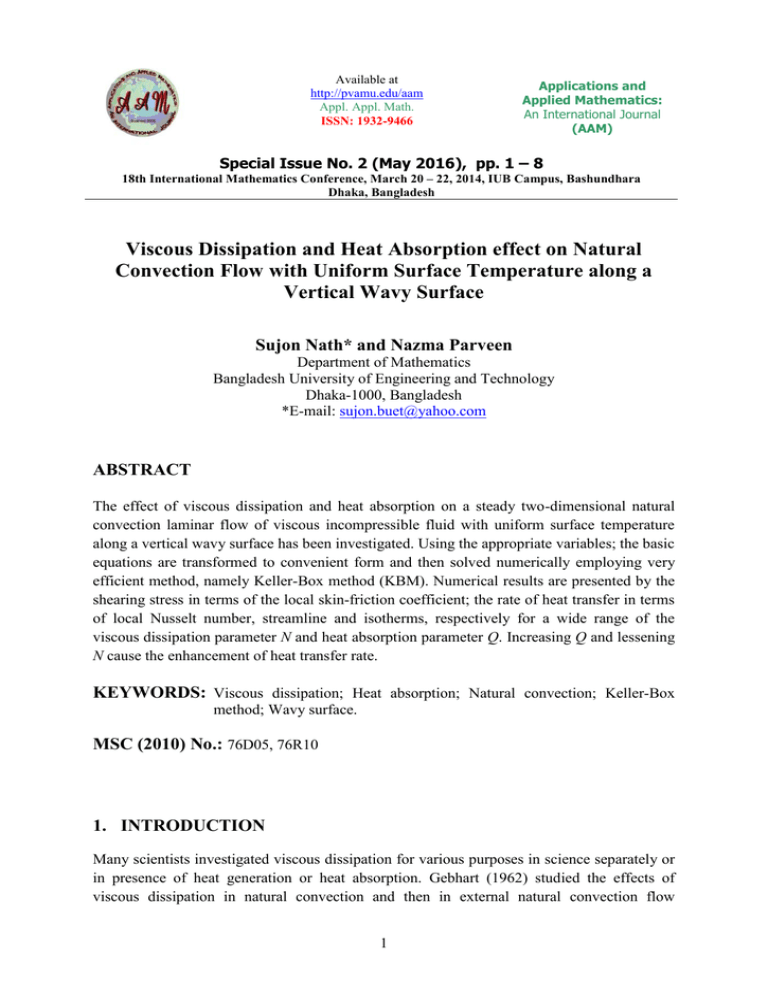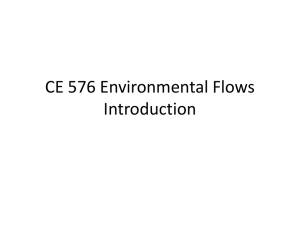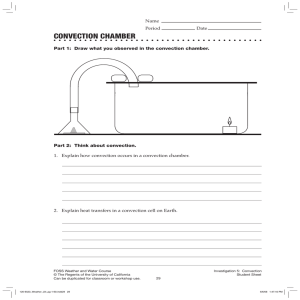Special Issue No. 2 (May 2016), pp. 1 –...
advertisement

Available at http://pvamu.edu/aam Appl. Appl. Math. ISSN: 1932-9466 Applications and Applied Mathematics: An International Journal (AAM) Special Issue No. 2 (May 2016), pp. 1 – 8 18th International Mathematics Conference, March 20 – 22, 2014, IUB Campus, Bashundhara Dhaka, Bangladesh Viscous Dissipation and Heat Absorption effect on Natural Convection Flow with Uniform Surface Temperature along a Vertical Wavy Surface Sujon Nath* and Nazma Parveen Department of Mathematics Bangladesh University of Engineering and Technology Dhaka-1000, Bangladesh *E-mail: sujon.buet@yahoo.com ABSTRACT The effect of viscous dissipation and heat absorption on a steady two-dimensional natural convection laminar flow of viscous incompressible fluid with uniform surface temperature along a vertical wavy surface has been investigated. Using the appropriate variables; the basic equations are transformed to convenient form and then solved numerically employing very efficient method, namely Keller-Box method (KBM). Numerical results are presented by the shearing stress in terms of the local skin-friction coefficient; the rate of heat transfer in terms of local Nusselt number, streamline and isotherms, respectively for a wide range of the viscous dissipation parameter N and heat absorption parameter Q. Increasing Q and lessening N cause the enhancement of heat transfer rate. KEYWORDS: Viscous dissipation; Heat absorption; Natural convection; Keller-Box method; Wavy surface. MSC (2010) No.: 76D05, 76R10 1. INTRODUCTION Many scientists investigated viscous dissipation for various purposes in science separately or in presence of heat generation or heat absorption. Gebhart (1962) studied the effects of viscous dissipation in natural convection and then in external natural convection flow 1 2 Sujon Nath and Nazma Parveen together with Mollendorf (1969). Natural convection was introduced along a vertical wavy surface by Yao (1983). Vajravelu and Hadjinolaou (1993) studied the heat transfer characteristics in the laminar boundary layer of a viscous fluid over a stretching sheet with viscous dissipation or frictional heating and internal heat generation. In this study they considered that the volumetric rate of heat generation, q [ W / m 3 ], should be qm = Q0(T- T), for T T and equal to zero for T T , where Q0 is the heat generation/absorption constant. Hossain and Rees (1999) first investigatedcombined heat and mass transfer in natural convection flow from a vertical wavy surface and then Jang et al. (2003) investigated natural convection heat and mass transfer along a vertical wavy surface. Molla et al. (2004) studied natural convection flow along a vertical wavy surface with uniform surface temperature in presence of heat generation/absorption. Alam et al. (2007) investigated viscous dissipation effects on MHD natural convection flow over a sphere in the presence of heat generation. Mamun et al. (2008) analyzed MHD– conjugate heat transfer analysis for a vertical flat plate in presence of viscous dissipation and heat generation. Devi and Kayalvizhi (2010) considered viscous dissipation and radiation effects on the thermal boundary layer flow with heat and mass transfer over a non-isothermal stretching sheet with internal heat generation embedded in a porous medium. Jha and Ajibade (2011) studied effect of viscous dissipation on natural convection flow between vertical parallel plates with time-periodic boundary conditions. Joule heating and viscous dissipation effects were investigated on MHD flow past a semi-infinite inclined plate with variable surface temperature by Palani and Kim (2011). Recently, Parveen and Alim (2012) have observed the effects of MHD natural convection flow along a vertical wavy surface in presence of heat generation/absorption with viscosity dependent on temperature. From the above one thing is clear that yet it has not been justified the effects of viscous dissipation and heat absorption together on natural convection flow along a vertical wavy surface. The object of the study is to show the effect of our present work. 2. FORMULATION OF THE PROBLEM The boundary layer analysis outlined below allows (X ) being arbitrary, but our detailed numerical work assumed that the surface exhibits sinusoidal deformations. The wavy surface may be described by nX Yw ( X ) sin L , (1) where L is the wave length associated with the wavy surface. The geometry of the wavy surface and the two-dimensional Cartesian coordinate system are shown in Figure 1. AAM: Intern. J., Special Issue, No. 2 (May 2016) 3 X U g V L T Tw Y Figure 1. The coordinate system and the physical model The conservation equations for the flow characterized with steady, laminar and twodimensional boundary layer; under the usual Boussinesq approximation, dimensionless form of the continuity, momentum and energy equations can be written as: u v 0, x y u (2) 1 p p u u 2u v Gr 4 x 1 x2 , x y x y y 2 (3) 2 1 p u u 2 u 4 x u v Gr x 1 x xx u 2 , 2 y y y x 2 u 1 2 u v 1 x2 Q N , 2 x y Pr y y where Pr and N Cp is the Prandtl number, Q k 2 Gr L2 C p (Tw T ) (4) (5) Q0 L2 CpGr 1 is the heat absorption parameter 2 is the viscous dissipation parameter. The following dimensionless variables are introduced for non-dimensionalizing the governing equations, L2 Y L 1 L 1 Gr 1 P , u Gr 2U , v Gr 4 (V xU ) Gr 4 , p 2 L 1 x X , L T T Tw T y , x d d , Gr g (Tw 2 T ) L3 , dX dx 4 Sujon Nath and Nazma Parveen where is the non-dimensional temperature function and (u, v) are the dimensionless velocity components. It can easily be seen that the convection induced by the wavy surface is described by equations (2)–(5). We further notice that, equation (5) indicates that the pressure gradient 1 along the y-direction is O(Gr 4 ) , which implies that lowest order pressure gradient along x direction can be determined from the inviscid flow solution. For the present problem this 1 pressure gradient ( p x 0 ) is zero. Equation (4) further shows that Gr 4 p / y is O(1) and is determined by the left-hand side of this equation. Thus, the elimination of p / y from equations (3) and (4) leads to 2 u u 1 2 u u v 1 x 2 x xx2 u 2 . x y y 1 x 1 x2 (6) The corresponding boundary conditions for the present problem are: u v 0, 1, u 0, y 0, y . at p 0, as (7) Now we introduce the following transformations to reduce the governing equations to a convenient form: 3 x 4 f ( x, ), yx 1 4 , ( x, ). (8) Introducing the transformations given in Equation (8) and into Equation (6) and (5), the following system of nonlinear equations are obtained 1 f 34 ff 12 x 2 x x 1 xx 2 x 2 f 1 f f x f f , 2 x 1 x x (9) 1 1 3 f 1 x2 f x 2Q Nxf 2 x f . Pr 4 x x (10) The boundary conditions (7) now take the following form: AAM: Intern. J., Special Issue, No. 2 (May 2016) f ( x, o) f ( x, o) 0, ( x, o) 1, f ( x, ) 0, ( x, ) 0. 5 (11) The local skin friction coefficient Cfx and the rate of heat transfer in terms of the local Nusselt number Nux takes the following form: C fx (Gr / x) 1 4 / 2 1 x2 f ( x, o), Nux (Gr / x) 1 4 1 x2 ( x, o). (12) (13) 3. METHOD OF SOLUTION The governing equations are solved numerically with the help of implicit finite difference method together with the Keller-Box scheme (1974). The discretization of momentum and energy equations are carried out with respect to non-dimensional coordinates x and η to convey the equations in finite difference form by approximating the functions and their derivatives in terms of central differences in both the coordinate directions. Then the required equations are to be linearized by using the Newton’s Quasi-linearization method. The linear algebraic equations can be written in a block matrix which forms a coefficient matrix. The whole procedure namely reduction to first order followed by central difference approximations, Newton’s Quasi-linearization method and the block Thomas algorithm, is well known as Keller-box method. 4. RESULTS AND DISCUSSION Here we have shown the combined effects of viscous dissipation and heat absorption on natural convection flow of viscous incompressible fluid along a vertical wavy surface. The skin friction coefficient Cfx, the rate of heat transfer in terms of Nusselt number Nux, the streamlines as well as the isotherms are shown graphically in Figures 2 to 5 for different values of the heat absorption parameter Q and the viscous dissipation parameter N. From the Figures 2(a) and (b), it is noted that the higher value of N accelerates the fluid flow and increases the temperature so with the increasing of viscous dissipation parameter N = (0.0, 0.4, 1.0, 1.5, 2.0), the skin friction coefficient Cfx increases along the upstream direction of the surface and the heat transfer rates in terms of the local Nusselt number Nux decreases. 6 Sujon Nath and Nazma Parveen 8 4 N = 0.0 N = 1.0 N = 1.5 N = 2.0 (b) 0 4 -4 2 00 N = 0.0 N = 1.0 N = 1.5 N = 2.0 Nux Cfx 6 (a) -8 2 4 x 6 8 10 -120 2 4 x 6 8 10 Figure 2. Effect of N on (a) skin friction coefficient Cfx and (b) rate of heat transfer Nuxwhile = 0.3and Pr = 1.73 From Figures 3(a) and (b), it is observed that the heat absorption mechanism does not create a layer of hot fluid near the surface so the temperature of the fluid decreases the surface temperature and temperature gradient increases. Thus the values of heat absorption parameter Q = (0.0, -0.2,-0.5, - 0.8) leads to decrease the local skin friction coefficient Cfx and increase the local rate of heat transfer Nux at different position of x. 2 4 Q = 0.0 Q = -0.2 Q = -0.5 Q = -0.8 Nux Cfx 1.5 1 2 0 0.5 00 Q = 0.0 Q = -0.2 Q = -0.5 Q = -0.8 (b) (a) 2 4 x 6 8 10 -20 2 4 x 6 8 10 Figure 3. Effect of Q on (a) skin friction coefficient Cfx and (b) rate of heat transfer Nux while = 0.3and Pr = 1.73 Figures 4 and 5 show the with and without effect of viscous dissipation parameter N and heat absorption parameter Q together on the formulation of streamlines and isotherms respectively while Pr = 1.73 and = 0.3. It is noted that with the effect of N, the velocity boundary layer becomes thicker and when Q increases the opposite results observed. The thermal boundary layer becomes thicker gradually for the effect of N. The temperature distribution decreases in presence of heat absorption parameter Q. The maximum value of max is 23.86 for N = 2.0. AAM: Intern. J., Special Issue, No. 2 (May 2016) 7 20 20 (a) (b) y y 7 10 5 2 4 x 6 8 20 2 4 x 14.32 23.86 6 8 10 20 (c) (d) x y y 6 8 1.59 00 10 2 12.7315.91 4 x 6 23.43 21.93 4 5.83 2 3.18 3 5 9.55 10 19.09 4.77 4.46 4.03 5.49 15 8 2.4 1.59 0.44 00 3.1 10 5.16 15 5 7.95 6.36 4.03 1.59 00 10 11.14 19.09 15 6.36 4.7 0.44 00 4.03 2.43 1.59 5 3.18 10 5.83 15 8 10 Figure 4. Streamlines for (a) N = 0.0, Q = 0.0 (b) N = 2.0, Q = 0.0 (c) N = 0.0, Q = -0.8 and (d) N = 2.0,Q = -0.8 while Pr = 1.73 and = 0.3 20 20 (b) 10 10 8 10 00 20 0. 10 4 8 10 7 0.4 2 4 x 6 0.07 7.76 0.60 8 0.5 5 10 00 2 4 x 6 0.07 33 3. 14.41 8 4. 43 4 0.15 9 0.07 0.07 0.07 0.0 y 10 y 10 0.2 2 11.62 .98 (d) 15 00 2 .22 16 x 6 1 (c) 15 5 45 0. 6 0.09 1.62 0.76 x 09 0. 4 5 8 0.3 0. 00 0.00 0.05 0 2 0.1 00 20 8 0.3 10 0. 5 y 15 y 15 0.00 (a) 10 Figure 5. Isotherms for (a) N = 0.0, Q = 0.0 (b) N = 2.0, Q = 0.0 (c) N = 0.0, Q = -0.8 and (d) N = 2.0, Q = -0.8 while Pr = 1.73 and = 0.3 5. CONCLUSION The effects of the heat absorption parameter Q and the viscous dissipation parameter N on natural convection flow of viscous incompressible fluid along a vertical wavy surface have been investigated. From the present investigation the following conclusions may be drawn: 8 Sujon Nath and Nazma Parveen ● The skin friction coefficient Cfx has increased and the rate of heat transfer in terms of Nusselt number Nux has decreased for increasing values of N and opposite results has happened for heat absorption parameter Q. ● Streamlines have changed slightly too upper and the same results are observed for thermal boundary layer thickness with the increasing values of viscous dissipation parameter N and opposite results have observed for heat absorption parameter Q. REFERENCES Alam, M.M., Alim, M.A. and Chowdhury, M.M.K. (2007). Viscous dissipation effects on MHD natural convection flow over a sphere in the presence of heat generation, Nonlinear Analysis: Modelling and Control, Vol. 12(4), 447-459. Devi, S.P.A. and Kayalvizhi, M. (2010). Viscous dissipation and radiation effects on the thermal boundary layer flow with heat and mass transfer over a non-isothermal stretching sheet with internal heat generation embedded in a porous medium, Int. J. Energy Technology, Vol. 2(20), pp. 1-10. Gebhart, B. (1962). Effects of viscous dissipation in natural convection, J. Fluid Mech., Vol. 14, pp. 225–232. Gebhart, B. and Mollendorf, J. (1969). Viscous dissipation in external natural convection flows, J. Fluid Mech., Vol. 38(1), pp. 97–107. Hossain, M.A. and Rees, D.A.S. (1999).Combined heat and mass transfer in natural convection flow from a vertical wavy surface, Acta Mechanica, Vol. 136, pp. 133–141. Jha, B.K. and Ajibade, A.O. (2011). Effect of viscous dissipation on natural convection flow between vertical parallel plates with time-periodic boundary conditions, J. Thermophysics and Aeromechanics, Vol. 18(4), pp. 561-571. Jang, J.H., Yan, W.M. and Liu, H.C. (2003). Natural convection heat and mass transfer along a vertical wavy surface, Int. J. Heat Mass Transfer, Vol.46, pp. 1075–1083. Keller, H.B. (1978). Numerical methods in boundary layer theory, Ann. Rev. Fluid Mech., Vol.10, pp. 417-433. Mamun, A.A., Chowdhury, Z.R., Azim, M.A. and Molla, M.M. (2008). MHD–conjugate heat transfer analysis for a vertical flat plate in presence of viscous dissipation and heat generation, Int. comm. Heat Transfer, Vol. 35, pp. 1275-1280. Molla, M.M., Hossain, M.A. and Yao, L.S. (2004). Natural convection flow along a vertical wavy surface with uniform surface temperature in presence of heat generation/absorption, Int. J. Therm. Sci., Vol.43, pp. 157-163. Palani, G. and Kim, K.Y. (2011). Joule heating and viscous dissipation effects on MHD flow past a semi-infinite inclined plate with variable surface temperature, J. Engineering Thermophysics, Vol. 20(4), pp. 501-517. Parveen, N. and Alim, M.A. (2012). MHD natural convection flow along a vertical wavy surface in presence of heat generation/absorption with viscosity dependent on temperature, J. Mechanical Engineering, Vol. ME 42 (1), pp. 47–55. Vejravelu, K. and Hadjinicolaou, A. (1993). Heat transfer in a viscous fluid over a stretching sheet with viscous dissipation and internal heat generation, Int. comm. Heat Transfer, Vol. 20, pp. 417-430. Yao, L.S. (1983). Natural convection along a vertical wavy surface, ASME J. Heat Transfer, Vol.105, pp. 465 - 468.




